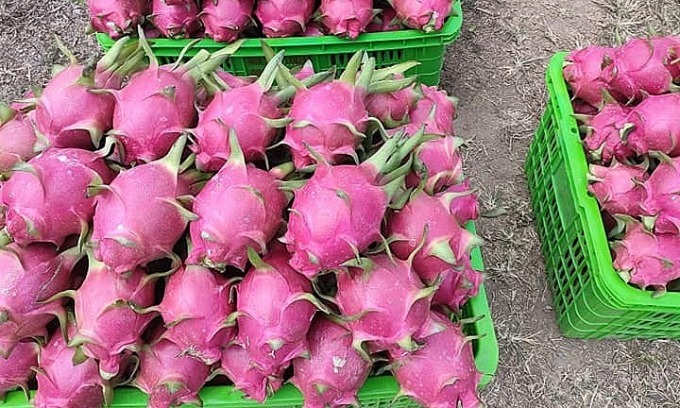
Dragon fruits harvested at a farm in Binh Thuan Province. Photo by VnExpress/Linh Dan
Nguyen Dinh Tung has been successful in exporting the premium ST25 rice to the U.S., but has suffered setbacks while exporting fruits.
A pioneer in exporting fresh fruits to the U.S., which he began in 2008, the chairman of Vina T&T Group, which accounts for a large proportion of the exports of agricultural items to that market, and vice president of the Vietnam Fruit and Vegetable Association, he is dubbed the “king” of fruit exports.
The U.S. is the second largest fruit and vegetable market for Vietnam after China. Vina T&T’s exports to that country last year were worth US$73 million, or nearly 60% of all Vietnamese exports.
At a recent business conference in Ho Chi Minh City, Tung spoke about his experience in dealing with the U.S. market.
To secure a strong foothold in the market, he worked hard to take ST25 there last year.
He discovered that Asian families in the U.S. favored Thai rice while cheap Vietnamese rice was sold mainly to people of Mexican descent.
So he shipped two containers of ST25 rice to the U.S., divided it into two-pound bags, and distributed it at churches attended by Vietnamese after Sunday mass.
After a few weeks some people began to ask where it was sold.
By then Tung had already shipped five more containers to the U.S. so that customers could be directed to Asian stores to buy it.
Stores that did not have ST25 rice contacted Vina T&T to buy it.
Tung said: “The Vietnamese community spread it by word of mouth very quickly, and so people went to stores to ask for ST25 rice. If it was not available, the store owner would look for me to order.
“Now we export six containers of ST25 rice a week to the U.S., or a few hundred containers a year.”

Nguyen Dinh Tung (with microphone), chairman of Vina T&T Group, at a recent business conference in HCMC. Photo courtesy of VBI Global
ST25 rice was a win but Tung also suffered many losses.
A bitter lesson he learned was from a batch of dragon fruit he exported to the U.S. in 2008 when it resumed imports of fresh vegetables and fruits from Vietnam.
U.S. regulations require
dragon fruit to be irradiated to eliminate fruit flies, but Vietnam did not have irradiation facilities at the time.
Son Son Irradiation Center was established subsequently, which resolved this problem for Tung.
But after more than 30 days at sea his dragon fruit consignment rotted, teaching him about the need for preservation.
The difficult part about exports of fruits and vegetables is that though they are perishable they can only be transported by sea because of the costs – 20 cents to ship a kilogram by sea versus $6 by air – involved.
Preservation technologies now enable his company to keep dragon fruit and longan fresh for 40 days and pomelo and coconut for 90 days.
In 2014 Tung managed to exported dragon fruit to the U.S. At the end of 2022 his company shipped the first container of pomelo.
“Currently we export 12 containers of pomelo every month though the market has competitive Chinese and Mexican goods,” he said.
Another mishap occurred recently when his company had to dump four containers of longan worth $76,000 each because of the weather.
The fruit was harvested when there was frost, and though there were no signs of anything unusual in the consignment, the longan had become moldy when it reached the U.S.
“Our industry faces great risk from the weather, not only in Vietnam but also in the U.S. Hot weather causes goods to spoil quickly.”
Tung attend international fairs to market his goods.
Vietnam’s fruit and vegetable exports in the first half of this year were estimated at $3 billion, almost equal to exports in the whole of 2022. In June they were worth $1 billion, the highest ever in a month.
Exports to the U.S. have been worth $118 million. Other major agricultural exports included seafood, cashew, coffee, and pepper.
Source: VNEXPRESS, 2023


